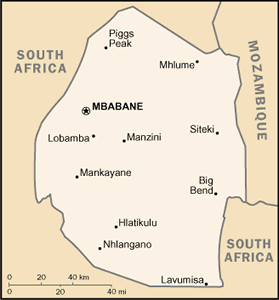The Geography of Swaziland
The Geography of Swaziland
Swazi Geography
Location: Southern Africa, between Mozambique and South Africa
Geographic coordinates: 26 30 S, 31 30 E
Map references: Africa
Area: total: 17,363 sq km land: 17,203 sq km water: 160 sq km
Area - comparative: slightly smaller than New Jersey
Land boundaries: total: 535 km border countries: Mozambique 105 km, South Africa 430 km
Coastline: 0 km (landlocked)
Maritime claims: none (landlocked)
Climate: varies from tropical to near temperate
Terrain: mostly mountains and hills; some moderately sloping plains
Elevation extremes: lowest point: Great Usutu River 21 m highest point: Emlembe 1,862 m
Natural resources: asbestos, coal, clay, cassiterite, hydropower, forests, small gold and diamond deposits, quarry stone, and talc
Land use: arable land: 10.25% permanent crops: 0.81% other: 88.94% (2005)
Irrigated land: 500 sq km (2003)
Natural hazards: drought
Environment - current issues: limited supplies of potable water; wildlife populations being depleted because of excessive hunting; overgrazing; soil degradation; soil erosion
Environment - international agreements: party to: Biodiversity, Climate Change, Climate Change-Kyoto Protocol, Desertification, Endangered Species, Hazardous Wastes, Ozone Layer Protection signed, but not ratified: Law of the Sea
Geography - note: landlocked; almost completely surrounded by South Africa


